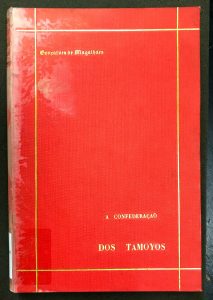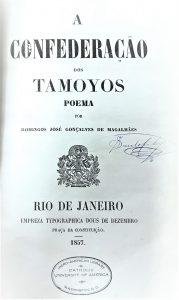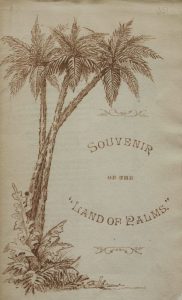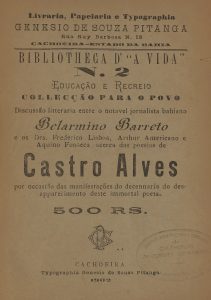Giovanna Gobbi Alves Araújo
Doutora em Literatura Brasileira, Universidade de São Paulo (CNPq/Fulbright)
Scholar-in-residence at the Brasiliana Guita and José Mindlin Library (BBM-USP)
giovannagobbi@alumni.usp.br

Manoel de Oliveira Lima’s efforts in curating a personal library throughout the years dedicated to diplomatic service, teaching, and research built a collection of immeasurable value not only for Latin American Studies, but for Brazilian Literature in particular.
Thanks to a Fulbright fellowship, I had the privilege of consulting a number of books and pamphlets related to Brazilian History and Literature at the Oliveira Lima Library, which have greatly contributed to my doctoral investigation of indigenous and Afro-Brazilian representation in nineteenth-century Brazilian epic poetry. Among myriads of holdings, the consultation of A confederação dos Tamoyos (1857), the Souvenir of the “Land of Palms” [1892?], and the Discussão litteraria entre o notavel jornalista bahiano Belarmino Barreto e os Drs. Frederico Lisboa, Arthur Americano e Aquino Fonseca acerca das poesias de Castro Alves, por occasião das manifestações do decennario do desapparecimento deste immortal poeta (1902) were notably significant in establishing the rhetorical-poetic traditions and the socio-cultural practices that underlay the construction of Indianist and abolitionist works committed to the rewriting of national history in the nineteenth century.
A confederação dos Tamoyos is an epic poem in ten cantos by Domingos José Gonçalves de Magalhães (1811-1882) that focuses on Native Brazilians’ resistance to Portuguese colonizers in the sixteenth century and the demise of indigenous peoples following their confrontation with European armed forces. Its mythological narrative, commissioned by the emperor Pedro II, was part of the political project of the Second Reign, which entailed the forging of national symbols through artistic, historiographic, and literary productions. Published in 1856, A confederação dos Tamoyos is not only Magalhães’s most prominent work, but a paradigm of nation-building literature for subsequent poets. OLL owns the 1857 edition, a reprint of the 1856 editio princeps by the same typographer, the Empresa Tipográfica Dous de Dezembro.

Souvenir of the “Land of Palms” is an extremely rare pamphlet that presents the poem “Canção do Exílio” written in Coimbra, Portugal, in 1843 by Antônio Gonçalves Dias (1823-1864) and its English version, “The exile’s song”, translated by D. M. Fox in Bornemouth, England, in 1892. The unique material also contains a handwritten French translation of the poem [La chanson de l’exile], possibly transcribed by Manoel de Oliveira Lima himself. There is no mention of the translator’s name in the French version of the poem. Its pages are decorated with sepia illustrations of tropical plants, palm trees in particular, which evoke the Edenic landscape depicted by European travelers to the New World. In a nostalgic mood, “Canção do exílio”, published in “Poesias Americanas”–Primeiros Cantos, inaugurated a particular mode of representation of the Brazilian natural landscape and an emotive viewpoint from which to represent Brazilian indigenous cultures. The publication of “Canção do Exílio” as a souvenir in the late nineteenth century illustrates the interest of anglophone and francophone readerships in Dias’s work, a testament to the longevity of his Indianist writings.


From books and pamphlets to manuscripts, the items related to Brazilian literature and culture in the Oliveira Lima Library (OLL) collection open up avenues of possibility for scholars of the Nineteenth-century and cast light on a complex period of Brazilian history.
Works cited
Barreto, Belarmino, and Frederico Lisboa. Discussão litteraria entre o notavel jornalista bahiano Belarmino Barreto e os Drs. Frederico Lisboa, Arthur Americano e Aquino Fonseca acerca das poesias de Castro Alves, por occasião das manifestações do decennario do desapparecimento deste immortal poeta. 3 v. Typographia Genesio de Souza Pitanga,1902.
Dias, Antônio Gonçalves. Souvenir of the “Land of Palms”. Translated by D. M. Fox, n.p.,[1892?].
Magalhães, Domingos José Gonçalves de. A confederação dos Tamoyos; poema. Rio de Janeiro: Empreza Typographica Dous de Dezembro, 1857.
